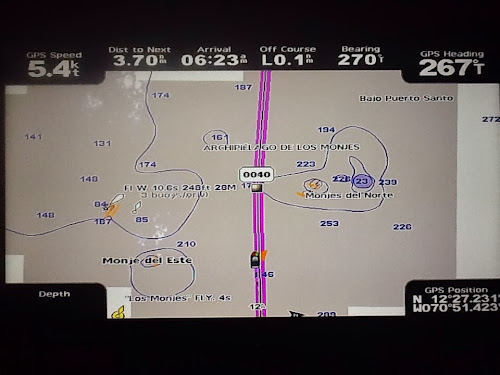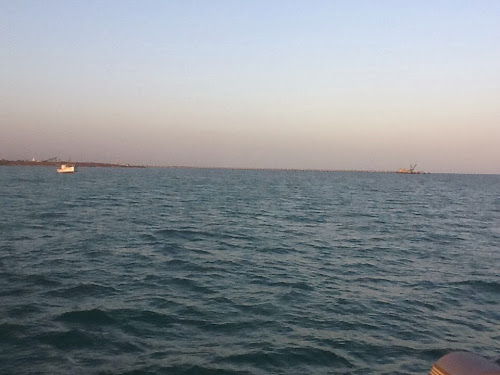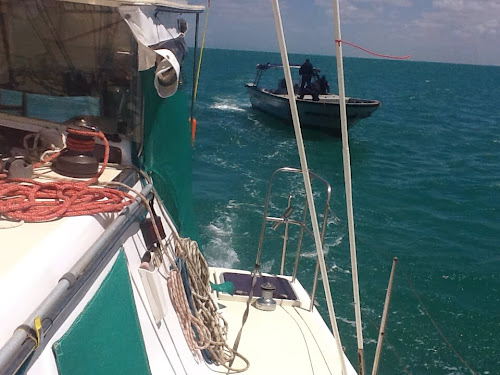After listening to Mrs. Parker's son for weather routing and looking on the internet, we decided to go straight to the mouth (5 nm off, that is) of the Magdelana River which is the largest and longest in Columbia. One has to be that far off because of the current and traffic both in vessels as well as flotsam (animals, trees, logs, etc.). Right now the seas have picked up from 1' when we left under power and little wind to 10' seas with wind abaft (behind) the beam (side) at 15-18 knots. A little rolls as the seas are also running with the wind. Skys are blue and clear. Hopefully this'll last 'till late this afternoon and we'll be snugged in at Puerto Valero. 17 nm to the rivers mouth, up wind and wave admittedly, and no trash or brown water yet. We're 5 nm away and the water has turned. Looks like we're sailing off the E coast of Florida: same yellow, pale green and brown mixed together. Talk about run-off.
Not a cow, tree, or anything. Just rolly poly dirty water. We forgot to turn off the watermaker's so I'll, probably, have to change the filters. Duh!
Too hazy for pictures of the marina at Puerto Valero which shows up on the chart at the point of the sand spit that looks like a deflated penis. Actually it is half a mile closer to shore than shown. The chart depiction is short by nearly half a mile which would have been a major disaster had we come in at night.
Good bye Puerto Valero where the Costagardia came aboard to check us out. Very little English and a newbee who wanted to see everything and then some: engine serial numbersxscdxwcscfy; second ID; etc. even had me sign the document he filled out in Espanol and print in my FL driver's license number. My US passport number wasn't enough!
Got a shower, drink, great enchilada dinner, and 9 hrs. rack time. Woke to clear ( again) skies and little wind. After bacon, egg, hash browns, and coffee, we raised the main, pulled up the anchor at around 0915 and headed WSW (248*) for San Blas some 30+ (we hope -) hours away. Winds and seas so far (it's barely 1000) are light at under 10 kts and 1'. By noon seas are up to 3-4' and winds are10-12 kts. OK motor sail 'cause we need to make the 262 nm trip in under 32 hours to arrive in the light. That means we have to maintain an average speed above 7.5 kts/hr.If you are interested in AIS and autopilot read on. Otherwise skip the next two sections.
AIS, Automatic Identification System, is an international vessel identification system that transmits vessel information over the VHF radio band. It reaches out from the vessel about 30 miles. It gives other vessels who have receivers particulars about the vessel such as name, type of vessel, cargo, direction, speed, destinations, etc. All vessels 100 tones and over are required to have and use them. Vessels show up on our chart plotter as green triangles which when "clicked" on give us all this myriad of info including Closest Approach in miles and time. What a wonderful thing to have especially at night or when they are below our horizon (only approx. 7-8 miles away) and when they're multiple "targets".
Also see the targets in the left corner in Cartagena Harbour
The autopilot is another helper that needs constant monitoring. When set to follow a course, it is constantly influenced by the wind (direction and strength) and currents. This is shown by the Off Course reading on the chart plotter as the bow swings left and right. One has to adjust it, seems like, every few minutes to get back within the 600' corridor on either side of the track where we like to be. Being off course on either side means a longer passage.
1600: The wind just gusted to 30 knots turning us into the wind. Sail boats do this as a safety measure: the stern is pushed around by the main overcoming the rudders. Given that the winds are expected to rise even further, we rolled up the jib snd turned fully into the wind and brought the main down while we crashed over the 10+' waves. It came down easily and folding nicely into the sail pack. I didn't get fully drenched, but wet enough pulling her down at the base of the mast. Back towards our course (we went off 0.6 nm off to the right (starboard and N)) and are still making good time: over 7.5 nm/hr average with just the jib back up.
0845, 2/22/2014: "Security, Security, Security! This is warship 04 at (position) preparing for live gunnery practice...." Oops...blundered into a firing range? After some consultation with warship 04 on the VHF we exchanged positions and an acknowledgement that they "saw" and "plotted" us 20 nm N of their position. They promised to try not to shell us given their course and aiming direction which should be behind us. Seas 5-7'; winds 11-14 knots abaft the beam; sunny with clouds; jib only 'till,after breakfast.
Most waves out here at the western end of the Caribbean Sea are doubles, a large wave followed in 4-6 seconds by another slightly smaller one. Both are followed by another big set 4 or 5 seconds later. This makes for a twisty, bumpy ride when combined with the wavelets that are created by the wind. Also, there is a cross wave pattern created by the currents (?) that juggles the whole thing into what a fellow cruiser called a "washing machine". For a catamaran with two hulls it's not so bad. But, for mono-maran, ouch. Things and people get a good tossing/bashing.
San Blas, Panama 30 hours after we left Puerto Valero. We managed to stay below the nasty weather just NNW of us which is there basically year round. It is supposed to be the World's third worst, on a par with Cape Horn. We did get a taste of it two nights ago, but here we skirted past. We did do it motor sailing to make it here in daylight having left Valero at around 0900. Simple, straight forward passage thru the reefs, hung a right then a left, and BINGO Nargana and Southern Comfort with Rob and Lauren blowing the horn celebrating our arrival.











